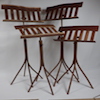I'm replacing a door but want to reuse the existing hinges and will pull the hinge pins and leave that half of the hinge attached to the jamb. The new door will need to have mortices cut to match the existing hinges.
I've found that the screws that attach hinges to the jamb will often strip when re-installed so if practical, I'd like to leave the jamb part of the hinge undisturbed.
I had good luck in a previous project like this by cutting the mortices, screwing the half hinge to the door and then mating it with the other half hinges in the jamb. I also realize there is zero room for error in this approach and I might have just been lucky.
What is your preferred method for cutting new mortices and installing hinges in a door like this?
Thanks for your comments and insight.




 Reply With Quote
Reply With Quote




